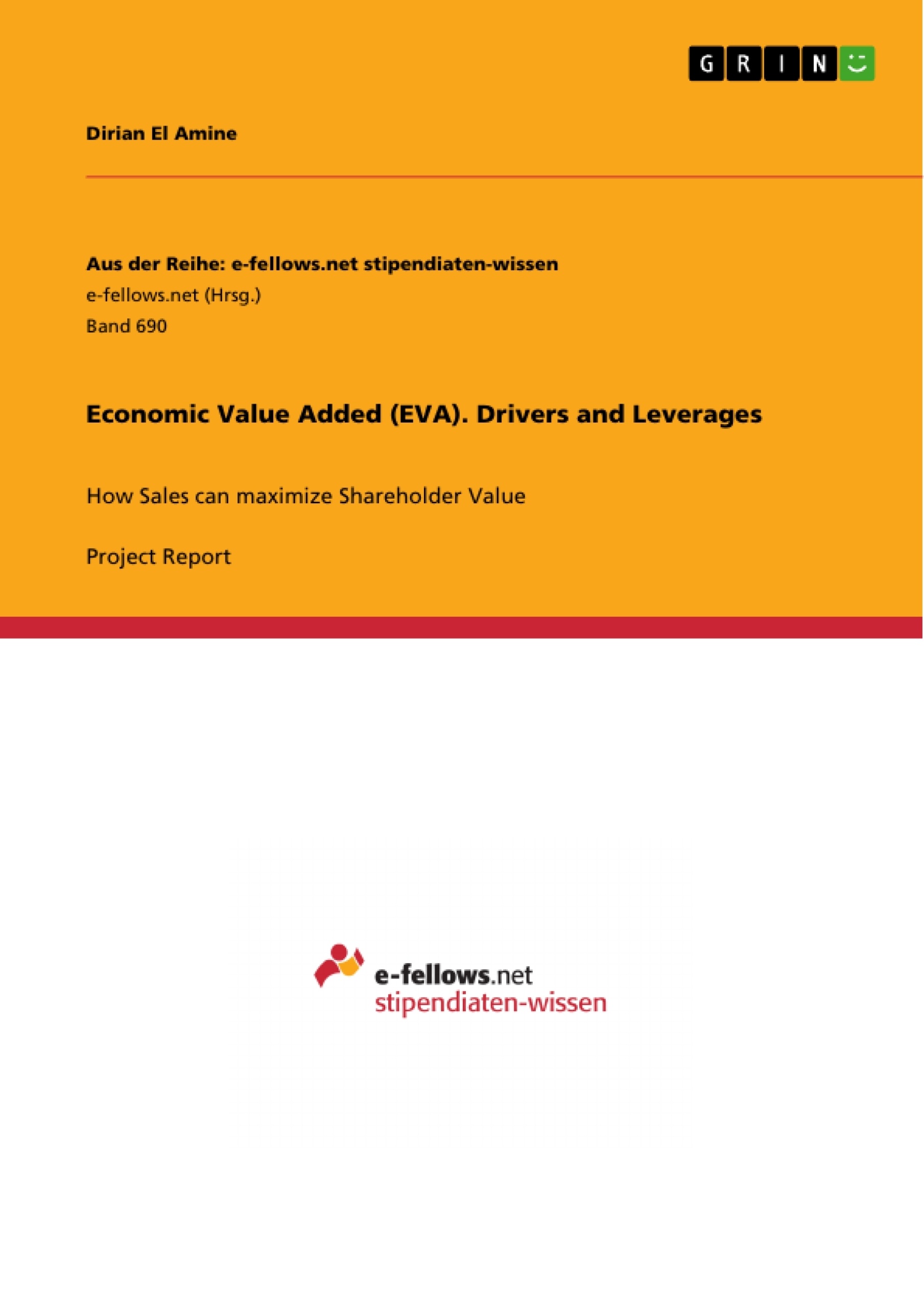From the contemporary dominance of the shareholder value approach arises more and more the necessity to precisely detect its performance as shareholder value is broadly seen as a significant indicator determining a company’s success or failure. However, measuring the performance of a company’s shareholder value can be very challenging. Hence, the purpose of this paper is to deal with a well-known approach that enables businesses to detect its shareholder value performance: Economic Value Added (EVA).
The thesis discusses the correlation between EVA and shareholder value, it further outlines its main drivers. In the second part, the paper elaborates on the specific links of the EVA approach to a regional Sales department and identifies the department’s main leverages on EVA. In order to detect the influence of the main operative decisions on EVA, the thesis introduces the key figure Effect-on-EVA. The applicability of Effect-on-EVA is shown in a model calculation. Above all, this project thesis shall create a profound practical value by sharpening the awareness of how to influence EVA in a positive way. In order to meet the recommended scope, the paper does not elaborate Asset Management, Accounts Receivable Management and Incentive Compensation in detail, but strives to point out the respective links to EVA.
Inhaltsverzeichnis (Table of Contents)
- 1. Introduction
- 1.1 Introduction to the topic
- 1.2 Purpose of this paper
- 2. Definition of Economic Value Added (EVA)
- 2.1 Short Overview
- 2.2 NOPAT (Net Operating Profits After Taxes)
- 2.3 Capital Charge
- 2.3.1 Basic formula
- 2.3.2 Net Operating Assets (NOA)
- 2.3.3 Weighted Average Cost of Capital (WACC)
- 3. Rationale and purpose of EVA
- 3.1 Rationale behind EVA
- 3.2 Purpose of EVA
- 3.2.1 EVA as capital market-oriented evaluation tool
- 3.2.2 EVA as performance measure for companies
- 3.2.3 EVA as a solution for the Principal-Agent approach
- 3.3 EVA and Shareholder Value
- 4. Drivers of EVA
- 4.1 Decisions with impact on EVA
- 4.1.1 Overview
- 4.1.2 Operative decisions
- 4.1.3 Investment decisions
- 4.1.4 Financing decisions
- 4.2 EVA driver tree
- 4.3 Drivers of NOPAT
- 4.4 Drivers of the Capital Charge
- 5. EVA in the specific business context
- 5.3 Importance of EVA for Global Players
- 5.5 Adapted leverages for a regional Sales department
- 5.5.1 Overview
- 5.5.2 Result Management
- 5.5.3 Working Capital Management
- 6. Effect-on-EVA
- 6.1 Purpose of Effect-on-EVA
- 6.2 Components of Effect-on-EVA
- 6.2.1 Overview
- 6.2.2 Effect-on-NOPAT
- 6.2.3 Effect-on-Capital-Charge
- 6.2.4 Example
- 6.3 Implementation
Zielsetzung und Themenschwerpunkte (Objectives and Key Themes)
The main objective of this paper is to explain the concept of Economic Value Added (EVA) and its drivers, demonstrating how sales can contribute to maximizing shareholder value.
- Definition and Calculation of EVA
- Rationale and Purpose of EVA
- Drivers of EVA: Operative, Investment, and Financing Decisions
- EVA in the Specific Business Context: Importance for Global Players and Regional Sales Departments
- Effect-on-EVA: Measuring the Impact of Decisions on EVA
Zusammenfassung der Kapitel (Chapter Summaries)
The paper begins with an introduction to the topic of EVA, defining its key concepts and outlining its importance for businesses. Chapters 2 and 3 delve into the definition, rationale, and purpose of EVA as a capital market-oriented evaluation tool and a performance measure for companies. Chapter 4 explores the drivers of EVA, focusing on how operative, investment, and financing decisions impact its calculation. The fifth chapter addresses the application of EVA in specific business contexts, highlighting its importance for global players and regional sales departments. Chapter 6 examines the 'Effect-on-EVA' framework, which aims to measure the impact of various decisions on EVA.
Schlüsselwörter (Keywords)
Key terms explored in this paper include Economic Value Added (EVA), NOPAT (Net Operating Profits After Taxes), Capital Charge, Weighted Average Cost of Capital (WACC), Net Operating Assets (NOA), Shareholder Value, Drivers of EVA, Operative, Investment, and Financing Decisions, Global Players, Regional Sales Departments, and Effect-on-EVA.
- Quote paper
- Dirian El Amine (Author), 2011, Economic Value Added (EVA). Drivers and Leverages, Munich, GRIN Verlag, https://www.grin.com/document/212413




